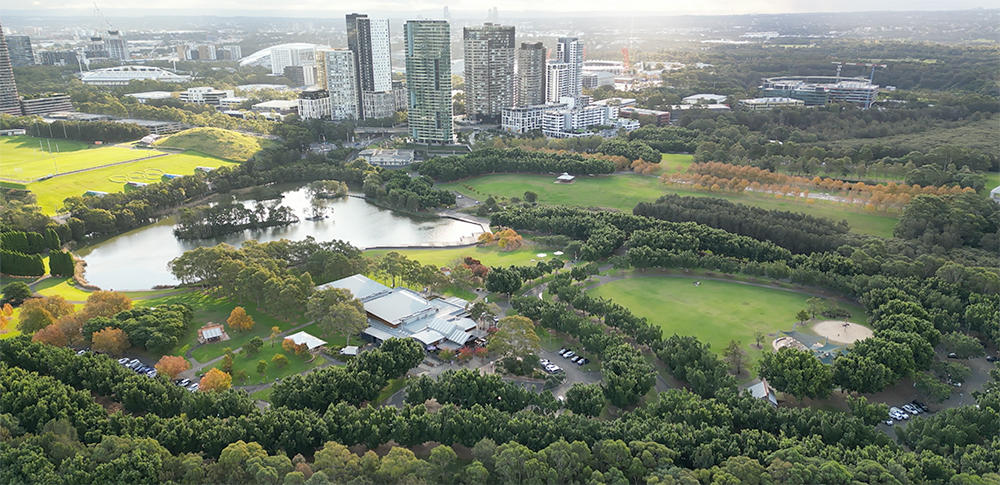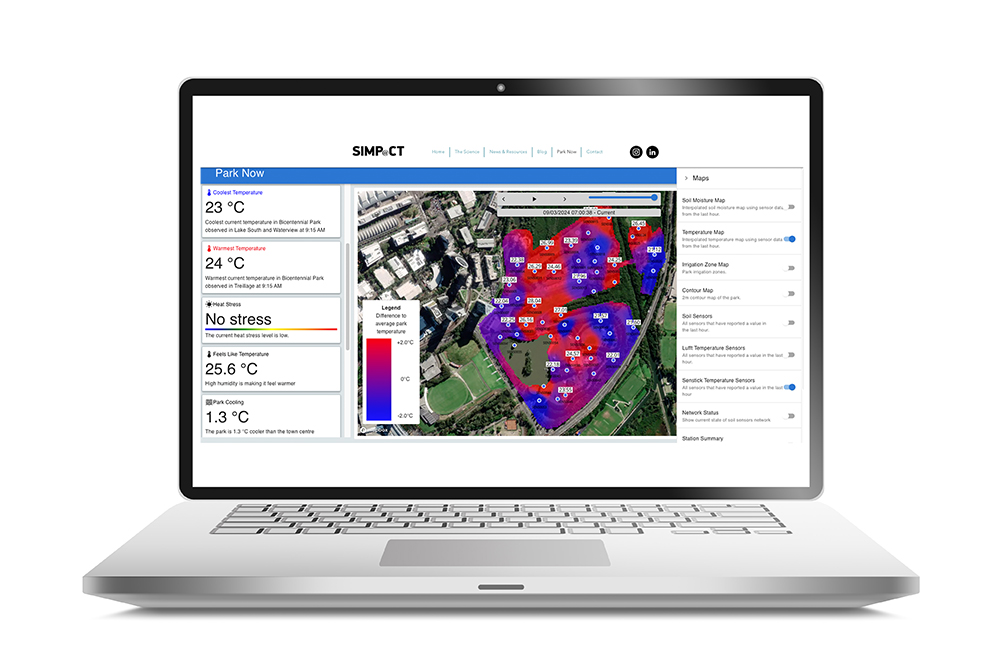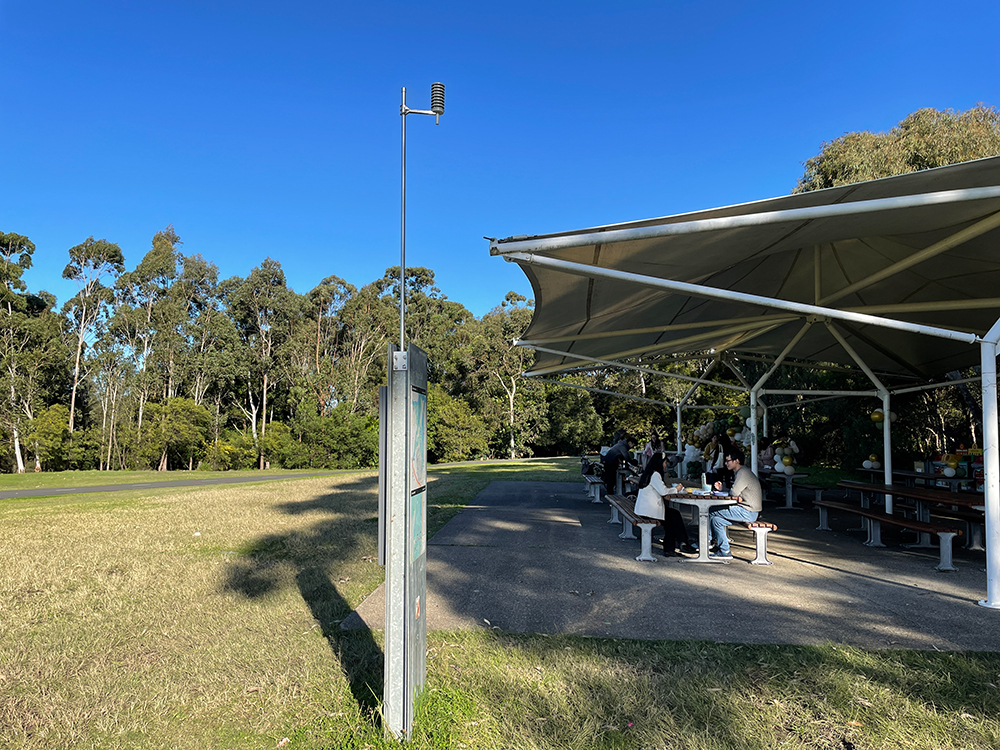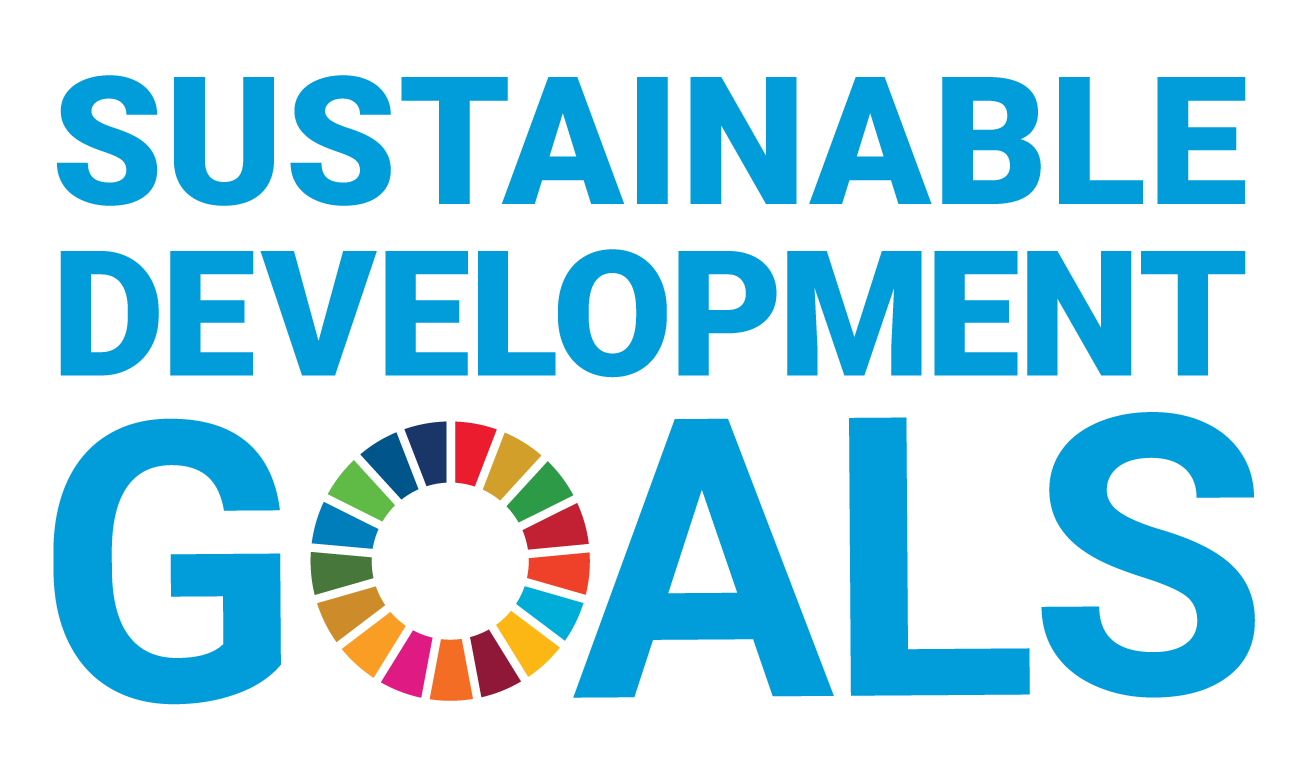You can search for courses, events, people, and anything else.
On a hot summer’s day in western Sydney, partially shaded urban parkland can offer respite from the heat of the city streets. With the assistance of an AI-driven, ultra-smart, park irrigation system, this natural cooling effect can be enhanced, spilling cooled air into surrounding streets.
Professor Sebastian Pfautsch, an urban green infrastructure researcher at Western Sydney University, has led a world-first project to use the irrigation network of Bicentennial Park — within Sydney Olympic Park — to maximise the cooling benefits that the park provides.
“We have shown that you can turn a city parkland into an urban air-conditioning system,” says Pfautsch, whose project has won a string of Australian awards, and was a finalist in the 2023 World Smart City Awards.
The major contributor to the cooling effect are the park's trees, says Pfautsch, who has a PhD in tree physiology and spent 15 years in fundamental plant research before moving into research on urban green spaces. As well as providing shade, trees act like giant natural evaporative coolers as they draw water up through their roots and then release it out of their leaves in a process called transpiration.
“A large tree can create 800 square metres of shade, while transpiring 400 to 600 litres of water each day to cool the air,” Pfautsch says. When the trees of Bicentennial Park are transpiring at maximum rates, the team has measured air temperatures in the park to be several degrees cooler than at nearby carparks.
To maintain maximum transpiration rates, however, there must be sufficient moisture in the soil.
“Hidden under Olympic Park is one of the biggest urban irrigation systems in the world, incorporating 300 kilometres of irrigation pipes fed with recycled greywater,” Pfautsch says. Bicentennial Park is so large, it can only be watered section by section to maintain the required water pressure. Its irrigation system features 200 separate sprinkler zones that can be independently switched on and off in a rolling sequence each night.
The idea for the Bicentennial Park urban cooling project came when the park’s irrigation system developed a fault during a heatwave in early 2020. Built on a former landfill site, without irrigation the park’s relatively thin topsoil dries out rapidly in hot conditions.
For residents in the surrounding dense urban development, Bicentennial Park is an invaluable recreational space attracting more than 1 million visitors each year. “When the irrigation system broke down, everything crisped up, it looked absolutely shocking,” says Pfautsch, who was contacted by park management asking for his advice on park recovery. “As we talked, the conversation quickly progressed from how to maintain a park under increasing pressure from the public and from climate change, to how could we maximise the cooling effect we can get from it.”
A CHANGE IN FOCUS
Pfautsch switched his research focus from forestry to green urban infrastructure after seeing green sites around western Sydney stripped of all their trees to build new suburbs as the region grew. “I thought, nobody is doing any research into the impacts of that kind of development in western Sydney,” Pfautsch says. As a major metropolitan centre that already regularly experiences temperatures more than 10oC higher than the eastern suburbs, western Sydney’s trees were being completely undervalued, Pfautsch thought. “Western Sydney University has a long history of urban planning, and when I pitched them the idea of urban green infrastructure research, they loved it,” he says.
After he moved to Western in 2017 to set up the programme, a series of hot summers produced record-breaking heatwaves across eastern Australia, with the highest temperatures recorded in western Sydney.
Penrith gained notoriety on 4 January 2020 as the hottest place on Earth, reaching 48.9oC. The region’s concentration of unshaded roads, carparks, buildings and other hard infrastructure would soak up heat all day, and then radiate it after sundown, keeping air temperatures high all night. “That’s particularly problematic for health, because your body doesn’t have a chance to recover before the next hot day,” Pfautsch says. Hospital admission spikes after a string of hot nights are well documented.
Under heatwave conditions — which are predicted to worsen due to climate change — the importance of urban green space becomes clear, Pfautsch says. “To counter the urban heat-island effect caused by all these hard surfaces, we can use what is called the ‘park cool-island effect’.”
Need to know
- Urban parklands can help cool cities.
- The SIMPaCT project has used irrigation to maximise cooling in Sydney’s Bicentennial Park.
- This has both public health and water savings benefits.
A COOL APPROACH
As Pfautsch studied Bicentennial Park’s irrigation system with a view to urban cooling, he quickly came to appreciate the system’s complexity, and pulled together a multidisciplinary team to tackle the project. As well as Sydney Water and the Sydney Olympic Park Authority, Pfautsch worked with the Institute of Sustainable Futures at the University of Technology Sydney, to install wireless air temperature and soil moisture sensors throughout the park. He also brought in researchers from Western’s School of Computer, Data and Mathematical Sciences, to write the AI algorithms and code to automate the system. Private industry assisted with the digital integration of the system.
“During normal operating conditions, we irrigate to maintain plant health,” Pfautsch explains. “But when it gets really hot, we switch to irrigation for cooling. Before the heat arrives, we increase irrigation so that the plants — particularly the trees — can transpire at maximum rates, which give us the maximum cooling effect.”
The team used machine learning to develop an AI solution, called SIMPaCT, that could automatically optimise Bicentennial Park’s complex nightly irrigation schedule. The AI’s decisions are based on data including the current humidity and soil moisture conditions in the park and the weather forecast from the Bureau of Meteorology. The AI also has a growing bank of irrigation experience from which to refine its decision making.
The first year of the project involved a lot of problem solving, Pfautsch says. “But since August 2023, we have completely let go, and the system is just doing what it’s supposed to do.” During the day, air temperatures in the park are typically several degrees lower compared to the nearby commercial and event precincts, but the biggest impact of the project can be measured at night. “You can get up to seven and a half degrees cooler air in the park,” Pfautsch declares proudly.
The cooling that the park generates markedly reduces the energy needs of nearby buildings, says Lizzy Pattinson, director of strategic projects and innovation in the Cities and Active Transport Team of the New South Wales Government. “It also generates public health benefits by reducing harmful impacts related to heat stress, and by making outdoor recreation more appealing,” she says.
Unlike most smart irrigation systems, saving water was not a project objective. But by switching from a human-operated system — where the tendency would be to err toward extra irrigation ‘just in case’ — to an automated data-driven system, water use in the park has fallen significantly. “We think water savings of 15–20% are possible, because of the precision application of water in the park,” Pfautsch reveals.
The team is now looking for other parks and green spaces in which to replicate the project. “SIMPaCT was designed to easily scale up or down, and we want to trial it in irrigation projects that are far less complex than Bicentennial Park,” Pfautsch says. Conversations ranging from implementation in nearby public parks and botanic gardens, to potential projects in the United Arab Emirates, are underway.
Meet the Academic | Professor Sebastian Pfautsch
Sebastian Pfautsch is a Professor of Urban Management and Planning and co-lead in People-centred Sustainable Precinct Design at the Urban Transformations Research Centre. He also coordinates the Research Theme Program at Western, which fosters new relationships between industry and academics. His multidisciplinary research is built around adaptation of cities to climate change impacts and specifically how to mitigate the complex issue of urban overheating. He investigates how climate-responsive planning and design can be used more effectively to cool urban spaces, reducing the impacts of heat on humans, the built environment, and ecosystems. With a background in forestry, plant ecophysiology and climate change, he works on strategies to expand blue-green infrastructure to make urban settlements cooler, healthier and better adapted to a hotter future. His evidence-based work informs government and industry organisations across Australia and internationally where it is the underpinning of policy change and design improvements. Sebastian co-authored Australia’s first urban green infrastructure handbook for Standards Australia and created an AI-based irrigation system for public parks. His projects have won multiple awards for innovation, sustainability and technology and his high-quality research is documented in the form of around 130 published works. He features regularly in the media, which in 2023 led to more than 380 headlines in 26 countries, published in 9 languages and had a potential online reach of 900 million people.
Credit
Future-Makers is published for Western Sydney University by Nature Research Custom Media, part of Springer Nature.
© (Computer) Kieran Stone/Moment/Getty; (Inside image) S. Pfautsch
© pjonesmoody/Unsplash







